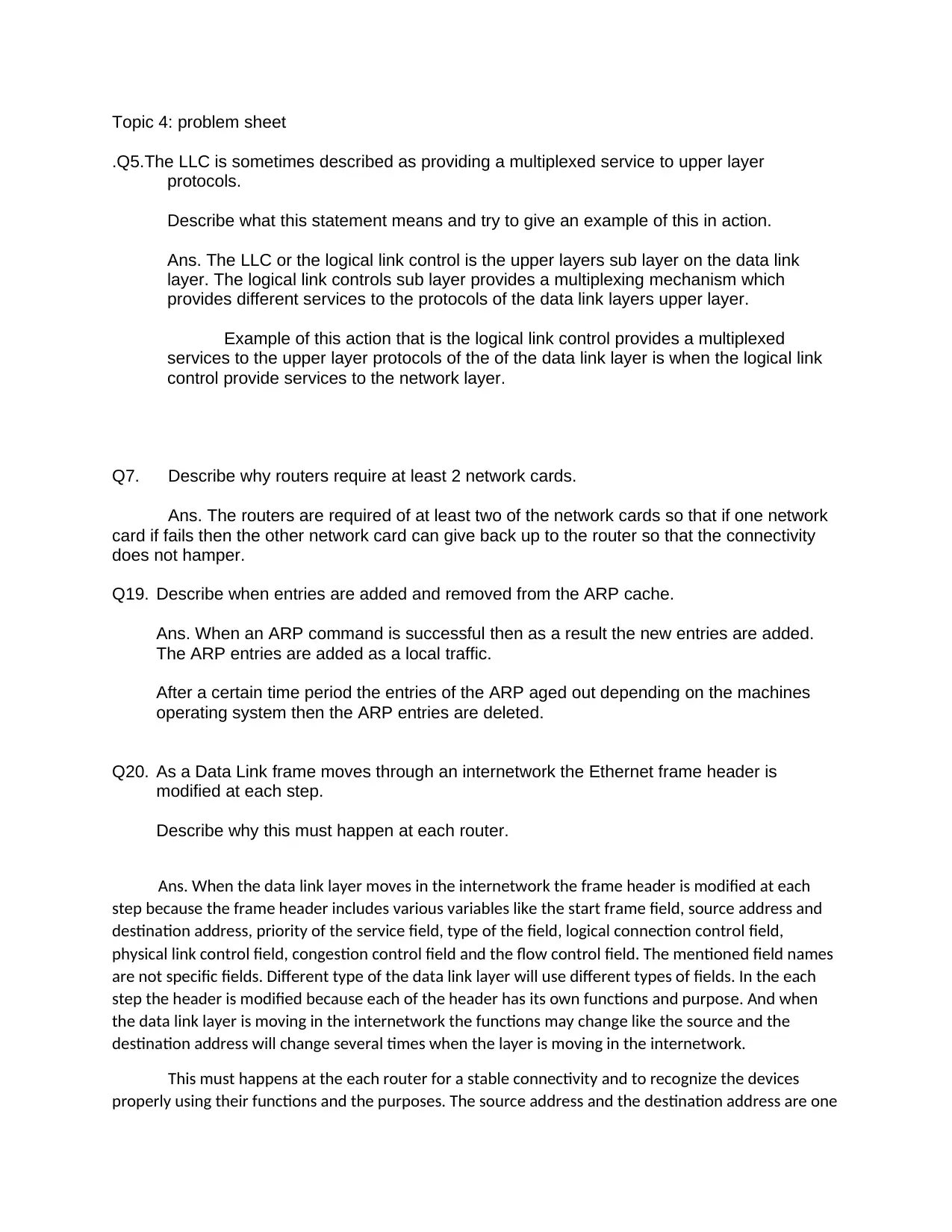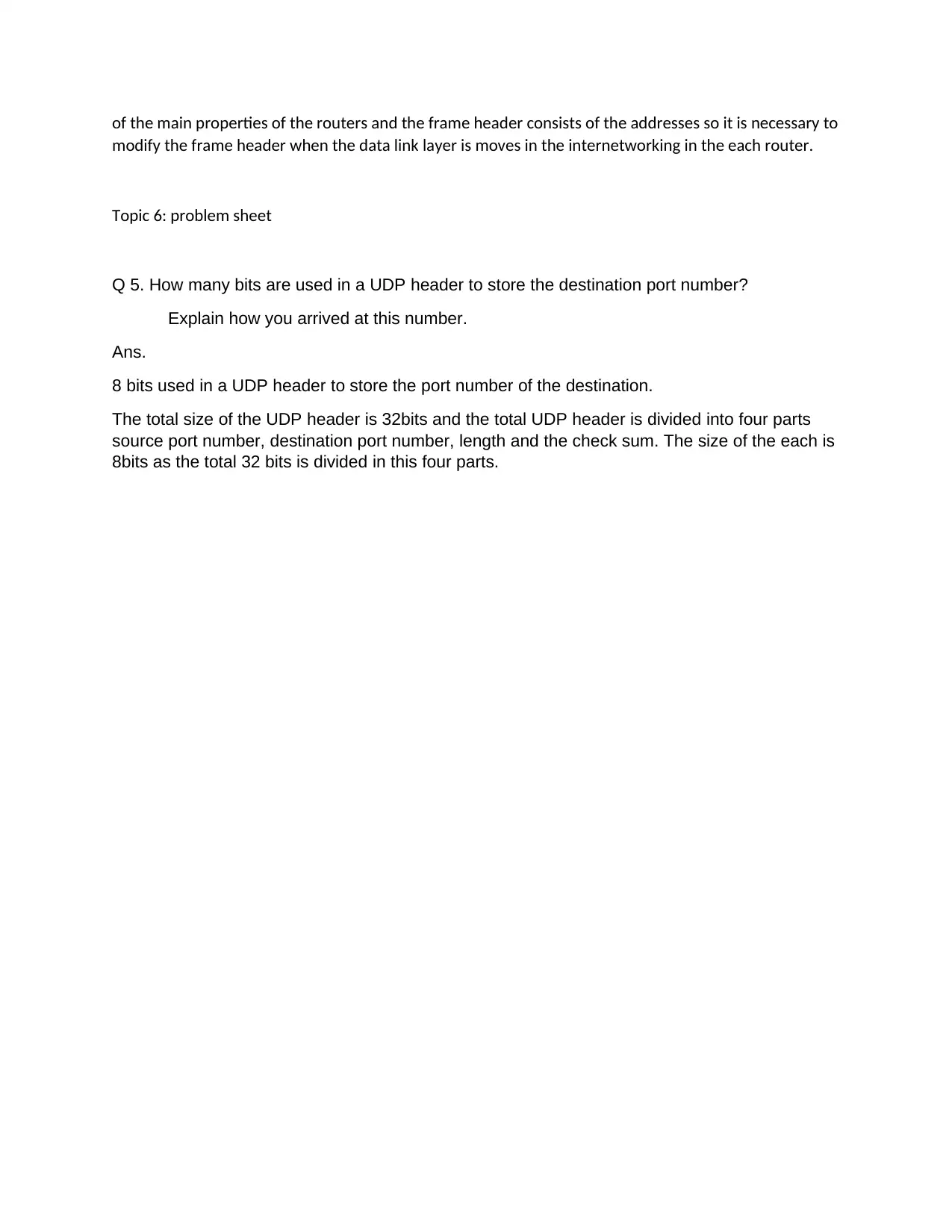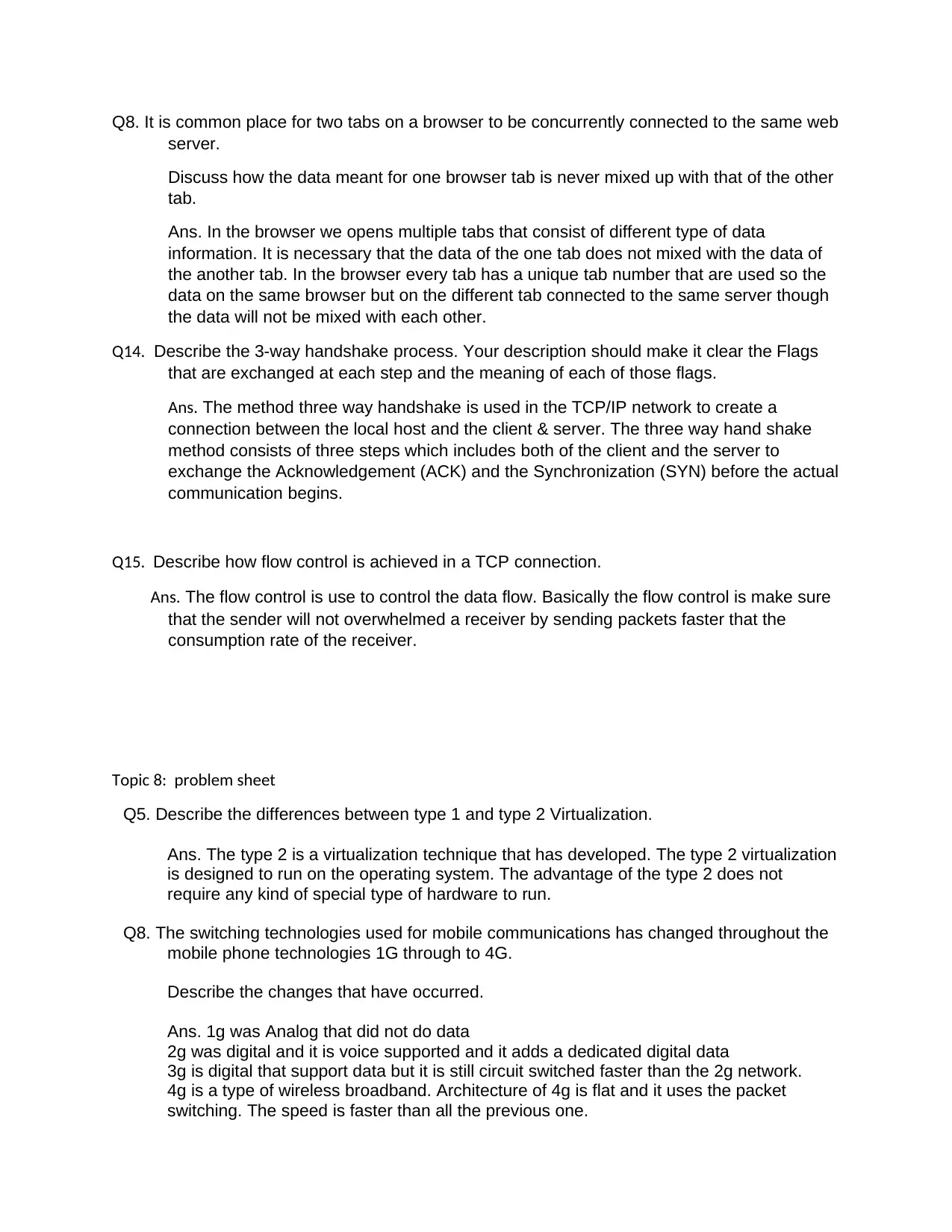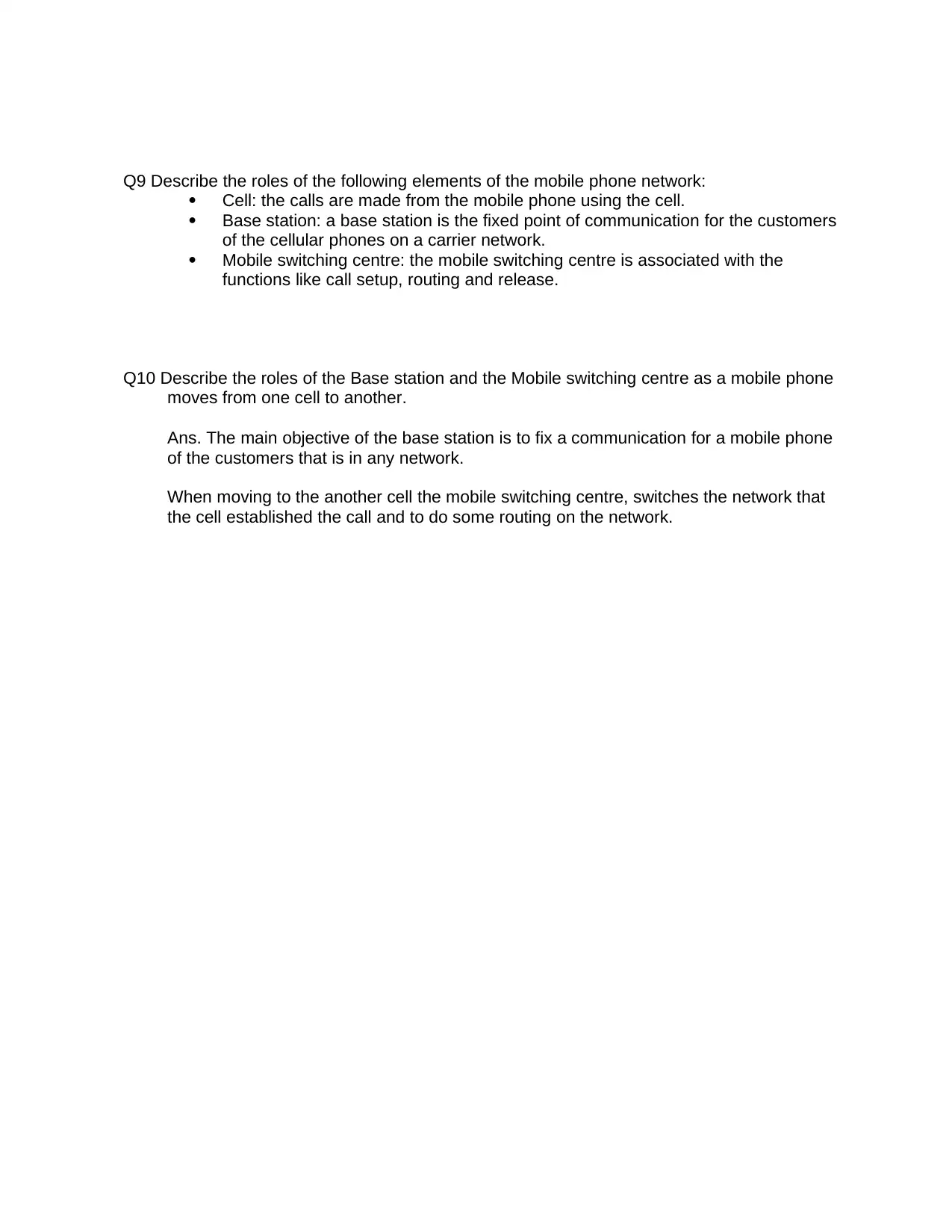ITECH1102 Networking and Security: Data Communication Solutions
VerifiedAdded on 2023/06/11
|4
|1183
|61
Homework Assignment
AI Summary
This assignment provides solutions to selected problems from the ITECH1102 Networking and Security course, covering topics such as LLC multiplexing, router network card requirements, ARP cache management, and Ethernet frame header modifications. It also addresses UDP header structure, c...

Topic 4: problem sheet
.Q5.The LLC is sometimes described as providing a multiplexed service to upper layer
protocols.
Describe what this statement means and try to give an example of this in action.
Ans. The LLC or the logical link control is the upper layers sub layer on the data link
layer. The logical link controls sub layer provides a multiplexing mechanism which
provides different services to the protocols of the data link layers upper layer.
Example of this action that is the logical link control provides a multiplexed
services to the upper layer protocols of the of the data link layer is when the logical link
control provide services to the network layer.
Q7. Describe why routers require at least 2 network cards.
Ans. The routers are required of at least two of the network cards so that if one network
card if fails then the other network card can give back up to the router so that the connectivity
does not hamper.
Q19. Describe when entries are added and removed from the ARP cache.
Ans. When an ARP command is successful then as a result the new entries are added.
The ARP entries are added as a local traffic.
After a certain time period the entries of the ARP aged out depending on the machines
operating system then the ARP entries are deleted.
Q20. As a Data Link frame moves through an internetwork the Ethernet frame header is
modified at each step.
Describe why this must happen at each router.
Ans. When the data link layer moves in the internetwork the frame header is modified at each
step because the frame header includes various variables like the start frame field, source address and
destination address, priority of the service field, type of the field, logical connection control field,
physical link control field, congestion control field and the flow control field. The mentioned field names
are not specific fields. Different type of the data link layer will use different types of fields. In the each
step the header is modified because each of the header has its own functions and purpose. And when
the data link layer is moving in the internetwork the functions may change like the source and the
destination address will change several times when the layer is moving in the internetwork.
This must happens at the each router for a stable connectivity and to recognize the devices
properly using their functions and the purposes. The source address and the destination address are one
.Q5.The LLC is sometimes described as providing a multiplexed service to upper layer
protocols.
Describe what this statement means and try to give an example of this in action.
Ans. The LLC or the logical link control is the upper layers sub layer on the data link
layer. The logical link controls sub layer provides a multiplexing mechanism which
provides different services to the protocols of the data link layers upper layer.
Example of this action that is the logical link control provides a multiplexed
services to the upper layer protocols of the of the data link layer is when the logical link
control provide services to the network layer.
Q7. Describe why routers require at least 2 network cards.
Ans. The routers are required of at least two of the network cards so that if one network
card if fails then the other network card can give back up to the router so that the connectivity
does not hamper.
Q19. Describe when entries are added and removed from the ARP cache.
Ans. When an ARP command is successful then as a result the new entries are added.
The ARP entries are added as a local traffic.
After a certain time period the entries of the ARP aged out depending on the machines
operating system then the ARP entries are deleted.
Q20. As a Data Link frame moves through an internetwork the Ethernet frame header is
modified at each step.
Describe why this must happen at each router.
Ans. When the data link layer moves in the internetwork the frame header is modified at each
step because the frame header includes various variables like the start frame field, source address and
destination address, priority of the service field, type of the field, logical connection control field,
physical link control field, congestion control field and the flow control field. The mentioned field names
are not specific fields. Different type of the data link layer will use different types of fields. In the each
step the header is modified because each of the header has its own functions and purpose. And when
the data link layer is moving in the internetwork the functions may change like the source and the
destination address will change several times when the layer is moving in the internetwork.
This must happens at the each router for a stable connectivity and to recognize the devices
properly using their functions and the purposes. The source address and the destination address are one
Paraphrase This Document
Need a fresh take? Get an instant paraphrase of this document with our AI Paraphraser

of the main properties of the routers and the frame header consists of the addresses so it is necessary to
modify the frame header when the data link layer is moves in the internetworking in the each router.
Topic 6: problem sheet
Q 5. How many bits are used in a UDP header to store the destination port number?
Explain how you arrived at this number.
Ans.
8 bits used in a UDP header to store the port number of the destination.
The total size of the UDP header is 32bits and the total UDP header is divided into four parts
source port number, destination port number, length and the check sum. The size of the each is
8bits as the total 32 bits is divided in this four parts.
modify the frame header when the data link layer is moves in the internetworking in the each router.
Topic 6: problem sheet
Q 5. How many bits are used in a UDP header to store the destination port number?
Explain how you arrived at this number.
Ans.
8 bits used in a UDP header to store the port number of the destination.
The total size of the UDP header is 32bits and the total UDP header is divided into four parts
source port number, destination port number, length and the check sum. The size of the each is
8bits as the total 32 bits is divided in this four parts.

Q8. It is common place for two tabs on a browser to be concurrently connected to the same web
server.
Discuss how the data meant for one browser tab is never mixed up with that of the other
tab.
Ans. In the browser we opens multiple tabs that consist of different type of data
information. It is necessary that the data of the one tab does not mixed with the data of
the another tab. In the browser every tab has a unique tab number that are used so the
data on the same browser but on the different tab connected to the same server though
the data will not be mixed with each other.
Q14. Describe the 3-way handshake process. Your description should make it clear the Flags
that are exchanged at each step and the meaning of each of those flags.
Ans. The method three way handshake is used in the TCP/IP network to create a
connection between the local host and the client & server. The three way hand shake
method consists of three steps which includes both of the client and the server to
exchange the Acknowledgement (ACK) and the Synchronization (SYN) before the actual
communication begins.
Q15. Describe how flow control is achieved in a TCP connection.
Ans. The flow control is use to control the data flow. Basically the flow control is make sure
that the sender will not overwhelmed a receiver by sending packets faster that the
consumption rate of the receiver.
Topic 8: problem sheet
Q5. Describe the differences between type 1 and type 2 Virtualization.
Ans. The type 2 is a virtualization technique that has developed. The type 2 virtualization
is designed to run on the operating system. The advantage of the type 2 does not
require any kind of special type of hardware to run.
Q8. The switching technologies used for mobile communications has changed throughout the
mobile phone technologies 1G through to 4G.
Describe the changes that have occurred.
Ans. 1g was Analog that did not do data
2g was digital and it is voice supported and it adds a dedicated digital data
3g is digital that support data but it is still circuit switched faster than the 2g network.
4g is a type of wireless broadband. Architecture of 4g is flat and it uses the packet
switching. The speed is faster than all the previous one.
server.
Discuss how the data meant for one browser tab is never mixed up with that of the other
tab.
Ans. In the browser we opens multiple tabs that consist of different type of data
information. It is necessary that the data of the one tab does not mixed with the data of
the another tab. In the browser every tab has a unique tab number that are used so the
data on the same browser but on the different tab connected to the same server though
the data will not be mixed with each other.
Q14. Describe the 3-way handshake process. Your description should make it clear the Flags
that are exchanged at each step and the meaning of each of those flags.
Ans. The method three way handshake is used in the TCP/IP network to create a
connection between the local host and the client & server. The three way hand shake
method consists of three steps which includes both of the client and the server to
exchange the Acknowledgement (ACK) and the Synchronization (SYN) before the actual
communication begins.
Q15. Describe how flow control is achieved in a TCP connection.
Ans. The flow control is use to control the data flow. Basically the flow control is make sure
that the sender will not overwhelmed a receiver by sending packets faster that the
consumption rate of the receiver.
Topic 8: problem sheet
Q5. Describe the differences between type 1 and type 2 Virtualization.
Ans. The type 2 is a virtualization technique that has developed. The type 2 virtualization
is designed to run on the operating system. The advantage of the type 2 does not
require any kind of special type of hardware to run.
Q8. The switching technologies used for mobile communications has changed throughout the
mobile phone technologies 1G through to 4G.
Describe the changes that have occurred.
Ans. 1g was Analog that did not do data
2g was digital and it is voice supported and it adds a dedicated digital data
3g is digital that support data but it is still circuit switched faster than the 2g network.
4g is a type of wireless broadband. Architecture of 4g is flat and it uses the packet
switching. The speed is faster than all the previous one.
⊘ This is a preview!⊘
Do you want full access?
Subscribe today to unlock all pages.

Trusted by 1+ million students worldwide

Q9 Describe the roles of the following elements of the mobile phone network:
Cell: the calls are made from the mobile phone using the cell.
Base station: a base station is the fixed point of communication for the customers
of the cellular phones on a carrier network.
Mobile switching centre: the mobile switching centre is associated with the
functions like call setup, routing and release.
Q10 Describe the roles of the Base station and the Mobile switching centre as a mobile phone
moves from one cell to another.
Ans. The main objective of the base station is to fix a communication for a mobile phone
of the customers that is in any network.
When moving to the another cell the mobile switching centre, switches the network that
the cell established the call and to do some routing on the network.
Cell: the calls are made from the mobile phone using the cell.
Base station: a base station is the fixed point of communication for the customers
of the cellular phones on a carrier network.
Mobile switching centre: the mobile switching centre is associated with the
functions like call setup, routing and release.
Q10 Describe the roles of the Base station and the Mobile switching centre as a mobile phone
moves from one cell to another.
Ans. The main objective of the base station is to fix a communication for a mobile phone
of the customers that is in any network.
When moving to the another cell the mobile switching centre, switches the network that
the cell established the call and to do some routing on the network.
1 out of 4
Related Documents
Your All-in-One AI-Powered Toolkit for Academic Success.
+13062052269
info@desklib.com
Available 24*7 on WhatsApp / Email
![[object Object]](/_next/static/media/star-bottom.7253800d.svg)
Unlock your academic potential
© 2024 | Zucol Services PVT LTD | All rights reserved.





